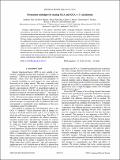Formation enthalpies by mixing GGA and GGA + U calculations
Author(s)
Jain, Anubhav; Hautier, Geoffroy; Ong, Shyue Ping; Moore, Charles Jacob; Fischer, Christopher C.; Persson, Kristin A.; Ceder, Gerbrand; ... Show more Show less
DownloadJain-2011-Formation enthalpies by mixing.pdf (616.1Kb)
PUBLISHER_POLICY
Publisher Policy
Article is made available in accordance with the publisher's policy and may be subject to US copyright law. Please refer to the publisher's site for terms of use.
Terms of use
Metadata
Show full item recordAbstract
Standard approximations to the density functional theory exchange-correlation functional have been extraordinary successful, but calculating formation enthalpies of reactions involving compounds with both localized and delocalized electronic states remains challenging. In this work we examine the shortcomings of the generalized gradient approximation (GGA) and GGA+U in accurately characterizing such difficult reactions. We then outline a methodology that mixes GGA and GGA+U total energies (using known binary formation data for calibration) to more accurately predict formation enthalpies. We demonstrate that for a test set of 49 ternary oxides, our methodology can reduce the mean absolute relative error in calculated formation enthalpies from approximately 7.7–21% in GGA+U to under 2%. As another example we show that neither GGA nor GGA+U alone accurately reproduces the Fe-P-O phase diagram; however, our mixed methodology successfully predicts all known phases as stable by naturally stitching together GGA and GGA+U results. As a final example we demonstrate how our technique can be applied to the calculation of the Li-conversion voltage of LiFeF[subscript 3]. Our results indicate that mixing energies of several functionals represents one avenue to improve the accuracy of total energy computations without affecting the cost of calculation.
Date issued
2011-07Department
Massachusetts Institute of Technology. Department of Materials Science and EngineeringJournal
Physical Review B
Publisher
American Physical Society
Citation
Jain, Anubhav et al. “Formation enthalpies by mixing GGA and GGA + U calculations.” Physical Review B 84 (2011): n. pag. Web. 17 Nov. 2011. © 2011 American Physical Society
Version: Final published version
ISSN
1098-0121
1550-235X